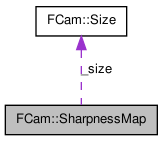
A sharpness map returned by the sharpness map generator. More...

Public Member Functions |
|
| SharpnessMap () | |
| The default sharpnes map carries no data. |
|
| SharpnessMap (Size s, int channels) | |
| Make an empty sharpness map of the given size and channel count. |
|
| unsigned | operator() (int x, int y, int c) const |
| Return sharpness at a particular location in a particular channel. |
|
| unsigned & | operator() (int x, int y, int c) |
| Return a reference into the sharpness map. |
|
| unsigned | operator() (int x, int y) const |
| Return sharpness at a particular location in the sharpness map summed over all channels. |
|
| bool | valid () const |
| Is it safe to dereference data and/or call operator(). |
|
| unsigned | channels () const |
| How many channels are there in the sharpness map. |
|
| const Size & | size () const |
| What resolution is the sharpness map. |
|
| int | height () const |
| How many rows does the sharpness map have. |
|
| int | width () const |
| How many columns does the sharpness map have. |
|
| unsigned * | data () |
| The raw sharpness data. |
|
A sharpness map returned by the sharpness map generator.
The sharpness map is the absolute value of a high-pass IIR filter summed over each region.
| FCam::SharpnessMap::SharpnessMap | ( | ) | [inline] |
The default sharpnes map carries no data.
| unsigned FCam::SharpnessMap::operator() | ( | int | x, | |
| int | y, | |||
| int | c | |||
| ) | const [inline] |
Return sharpness at a particular location in a particular channel.
The order of the channels is RGB in the sensor's raw color space. The absolute sharpness carries only relative meaning, and depends on the particular sharpness-detecting filter used by the implementation. Be aware that for linear filters, brighter regions will have a higher response due to Poisson noise. These numbers can be quite large, so if you're summing up the sharpness map, you should take care to prevent overflow.
| unsigned& FCam::SharpnessMap::operator() | ( | int | x, | |
| int | y, | |||
| int | c | |||
| ) | [inline] |
Return a reference into the sharpness map.
This is useful if you want to generate your own fake sharpness maps.
| unsigned FCam::SharpnessMap::operator() | ( | int | x, | |
| int | y | |||
| ) | const [inline] |
Return sharpness at a particular location in the sharpness map summed over all channels.
| bool FCam::SharpnessMap::valid | ( | ) | const [inline] |
Is it safe to dereference data and/or call operator().
| unsigned FCam::SharpnessMap::channels | ( | ) | const [inline] |
How many channels are there in the sharpness map.
Typically this is 3.
| unsigned* FCam::SharpnessMap::data | ( | ) | [inline] |
The raw sharpness data.
Stored in a similar order to an image: rows, then columns, then channels.
| Copyright (c) 2012, Nokia Corporation and/or its subsidiary(-ies). All rights reserved. See Copyright. |
MeeGo 1.2 Harmattan API
|




